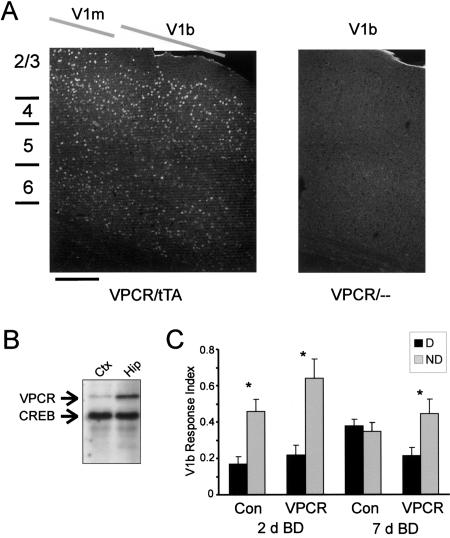Figure 7.
Enhancement of CREB activity by expression of VP16-CREB leads to increased stability of cortical plasticity in adults. (A) VP16-CREB is expressed in the visual cortex of VP16-CREB/tTA double-transgenic mice, but not in VP16-CREB/- single transgenic mice. The confocal composites shown are of VP16 immunofluorescence. VP16-CREB expression was strongest in layers 2 and 3, and weaker in other layers of the cortex; there was similar expression in V1m and V1b (location of V1m and V1b determined by bisbenzimide cytoarchitectonics). Scale bar, ∼200 μm. (VPCR) VP16-CREB; (tTA) tetracycline-regulated transactivator. (B) Western blotting using visual cortex and hippocampus samples from VP16-CREB/tTA mice. The antibody detected much less VP16-CREB than CREB; there was much less expression of VP16-CREB in the cortex than in the hippocampus. (C) VP16-CREB expressing mice show greater stability of ocular dominance plasticity. Mice were subjected to 2 d of monocular deprivation, followed by 2 or 7 d of binocular deprivation. We then opened the deprived (D) or nondeprived (ND) eye. After 2 d of binocular deprivation, there was a highly significant effect of deprivation (P < 0.001, ANOVA), but no effect of transgene and no significant deprivation × transgene interaction. This indicates that both VP16-CREB/tTA mice and controls exhibit ocular dominance shift after 2 d of binocular deprivation. After 7 d of binocular deprivation, there was a deprivation effect in VP16-CREB mice, but not in control mice. ANOVA shows a significant deprivation × transgene interaction (P = 0.02). (Asterisks) Significant paired comparisons using the Bonferroni correction (P < 0.01 for 2 d BD; P < 0.05 for 7 d BD). n = five to eight mice for all groups.

